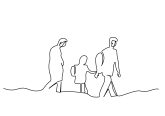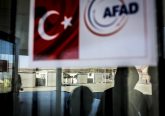The charming Greek island of Lesbos, once famous for its rich heritage, ouzo, and olive oil, is a notorious hotspot for refugees. The symbolic Statue of Liberty, standing tall since 1922, serves as a reminder of the island’s history following the Asia Minor war when thousands of Greeks fled to Lesbos. Located in the Aegean Sea near Turkey, the island became a focal point during the refugee crisis in 2015 when approximately 379,000 refugees arrived. Refugees continue to arrive every day, and around 17,029 people of the island’s population of over 86,000 people are refugees, the majority of whom are children (43 percent) many unaccompanied (18 percent) – from war torn countries.

With the influx of refugees, the island has become a tinderbox, a microcosm of today’s political reality across the globe with many nationalists demanding the closure of the camps and borders. Last March, there was an uproar over a giant cross erected to deter migrants following the destruction of a similar cross last year. Xenophobia is on the rise, which Vasili, a local Lesbian, founder of Change Makers Lab attributes to misinformation about refugees creating a climate of fear. The following account is based on tells the personal stories of refugees and those working with them in Lesbos.

The story of Ahmed, a 23-year-old refugee from Baghdad, is representative of what many living here have gone through. Traumatized by war in his country, the young refugee, who speaks multiple languages through his exposure to various nationalities in the camps, knows nothing but a life of warfare.
“I was only 7 years old when the Iraq war started in 2003. Whilst the country was burning down, I was playing football with my friends. I saw people dying everyday. Half of my family died. I had no choice but to leave.”
Refugees on the island, like Ahmed, live in camps, such as Kare Tepe and Moria, or informal settlements scattered across in the most unlikely of places. Kare Tepe is run by NGOs and is acclaimed as the best camp in Europe. In stark contrast, Moria, the national camp run by the government, is known to be one of Europe’s deadliest camps. Residing in Moria, iSally is, a 20-year-old pregnant Syrian refugee from Deir ez-Zor. Eager to expose the camp’s horrid conditions, she provides me with undercover access. Unlike the other camps, it is illegal for journalists and most NGOs to enter unless authorized by the Greek authorities. Cautious of the dangers for outsiders, Sally tightly links arms with me and insists on no photos and limited communication inside so as to avoid suspicion. This courageous youth, who nearly drowned at sea, describes her despair:
“The conditions are inhumane. My back aches from the rocky floor where our tent is perched and I’m always sick from the awful food in the camp. I wish I could cook for myself,” said the pale-faced Syrian, sporting a soft pink headscarf, dusty black ‘abaya’ cloak, with swollen feet squashed into worn out flat rubber shoes.”
After passing through the main gate, tensions run high in the camp becomes immediately apparent. Young males crowd the dusty makeshift pathways, their expressions filled with sadness and frustration at their grueling predicament. Sally holds my hand tighter whilst passing the new arrivals tent, known as the ‘The Rat Hole.’ Meant to host 110 people, it is currently home for 800 people, half of whom are unaccompanied minors. With just three toilets and three showers, it is completely inadequate. Close by is an unsightly prison-like establishment where housing and asylum interviews with NGOs and the Greek authorities take place. Located at the far end of the camp, through a broken fence is the informal camp extension made up of countless make-shift tents, one of which belongs to Sally and her husband.

Traumatic tales like Sally’s are commonplace amongst refugees in Moria. Nazgol, an 18-year-old artist who fled Tehran, Iran, arrived on Lesbos as an unaccompanied minor and was placed with the majority of unaccompanied minors in Moria’s ‘safe zone’ where she lived in an ISO box with a group of girls. Nazgol’s experience in the ‘safe zone’ was anything but safe and secure.
“People die there all the time. Recently, a 6 year old was raped and killed and one African boy died from the cold in the tent. Just yesterday, a car killed a little boy,” alleged a teary-eyed Nazgol in fluent Arabic, her eyes watering from the painful memories of the trauma she has passed through.”
Nazgol, with a distinctive brow piercing, was pushed to learn Arabic in the camp since it is one of the main languages. Following her parent’s death in a car crash and evading a forced arranged marriage to an army officer, she escaped from Iran. Like most, she came to Lesbos by boat from Turkey after a treacherous journey walking endlessly without sleep for days. The risk of stopping to rest and being kidnapped by smugglers or raped is just part of the many dangers refugees face. Now in a safe house in Mytillene after a period in Moria and what she describes as a harrowing experience in Athens, Nazgol has found some stability and is engaged to a young Afghan.
Not all refugees are as fortunate to be placed in a safe house; some remain in the camps for prolonged periods. Ahmed, who also lived in Moria for a year and now resides in the neighbouring informal camp run by the NGO “Together for Better Days,” describes his hellish experience in Moria.
“Life in Moria is hell. When I was there members of ISIS had fled Syria and infiltrated the camp and were causing sectarian strife between Sunni and Shia Muslims. Stabbings were commonplace.”

The conditions in the neighboring informal camp run by ‘Together for Better Days’ are undeniably much better than Moria though not on par with Kare Tepe. The atmosphere is less tense, and there is a certain sense of peace amongst the camp residents. Mona, a jovial-faced 19-year-old Somali from Mogadishu who escaped Al-Qaeda, ISIS and Al-Shabab, shares her sense of calm: “It’s better here. I feel safe and at peace. We are finally free.”
Pregnant with her first child at 17, her mother decided to flee after members of Al-Shabab entered their home insisting on marrying her two daughters following the disappearance of her husband. Despite the traumatic experience, Mona remains optimistic about her future. She is hoping to make it to Sweden in the near future. When asked why Sweden, the smiley youth says she’s heard it is a nice country where people are treated well. Her camp neighbour, a fellow Somali, Naema, shares similar aspirations after fleeing her abusive husband with her three kids. Naema hopes to re-build her life in Germany where she has friends and relatives; social capital is an enticing factor for most.
What becomes clear in many of my conversations is that many suffering people hope to return to their homeland one day. For them, Lesbos and Europe are merely transitory zones until stability resumes in their countries. Mahmoud, a middle-aged Syrian refugee doctor-turned-chef, refused asylum in France in order to be closer to his country and help his people on Lesbos and the island of Samos, where he has set up a medical administration office.
“I want to go back home to Syria when it’s safe. I never wanted to leave,” asserted Mahmoud, whilst taking a puff of his bubbling sheisha on his balcony, conveniently overlooking his restaurant called ‘Reem’.

An evident pattern amongst refugees emerged when asked about their dreams; the ability to dream had been lost. Graffiti, expressing this very notion with the words ‘You Stole Our Dreams,’ visibly splattered in bold blue letters on the caged walls outside Moria.
“My reality has become my dream. My dream is to know what my dreams are again,” explained a melancholic Ahmed.
Like Ahmed, Mahmoud maintains that dreams are only possible when basic human needs are met. Whilst international community continues to turn a blind eye, thousands of refugees are living and suffering in what were supposed to be temporary camps on Lesbos. They are stuck in limbo robbed of even their dreams.





